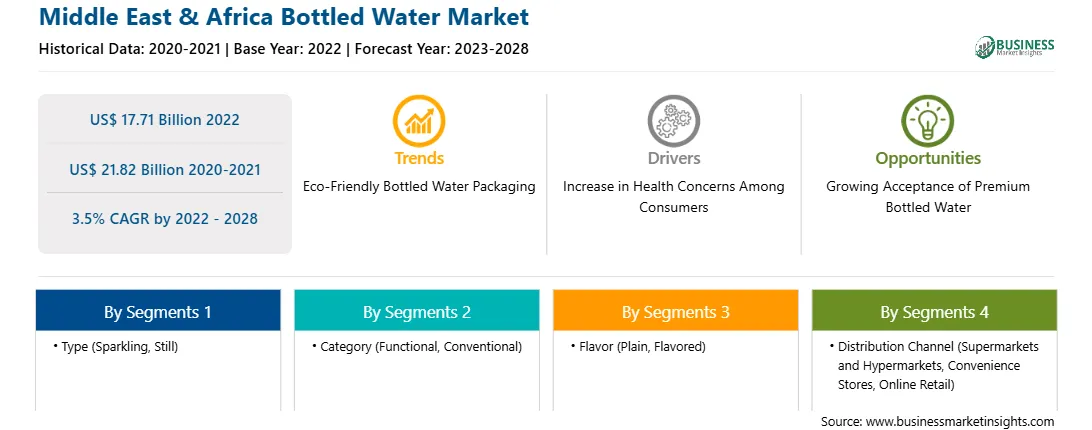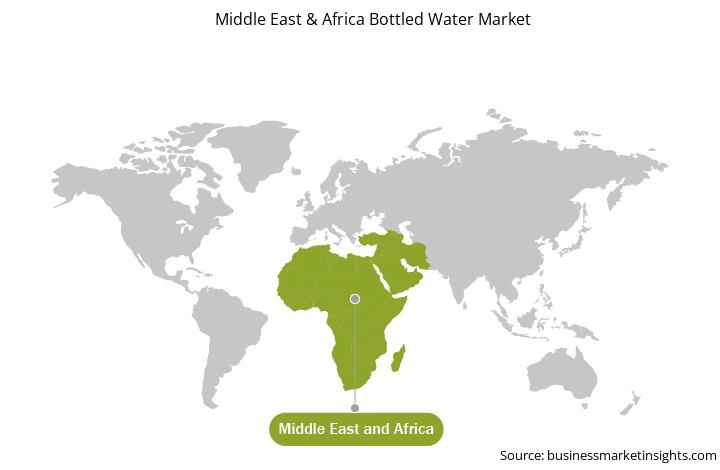There is an increasing demand for bottled water due to rising health concerns among consumers about consuming contaminated water. Access to safe and clean drinking water remains a challenge in many parts of the developing world. Such conditions raise consumers' hygiene standards toward drinking safe water to maintain a healthy life. In places where people have no access to a safe water system or their water system does not supply high-quality water, bottled water is used as an alternative. The heightened awareness of the need to stay hydrated has also been driving the Middle East & Africa bottled water market.
The rise in health awareness among consumers is leading to a surge in the adoption of new products with health benefits. Bottled water manufacturing companies are also extensively introducing new products to provide consumers with functional benefits, better taste, and convenience. For instance, in 2019, Nestlé launched Nestlé Pure Life Active—the first alkaline variant of the brand's bottled water produced locally. Such innovative products offer several health benefits to consumers. As a result, many health-conscious people are choosing bottled water over other beverages, which also contributes to the increase in sales. Thus, the Middle East & Africa bottled water market is expected to grow at a notable CAGR during the forecast period.

Strategic insights for the Middle East & Africa Bottled Water provides data-driven analysis of the industry landscape, including current trends, key players, and regional nuances. These insights offer actionable recommendations, enabling readers to differentiate themselves from competitors by identifying untapped segments or developing unique value propositions. Leveraging data analytics, these insights help industry players anticipate the market shifts, whether investors, manufacturers, or other stakeholders. A future-oriented perspective is essential, helping stakeholders anticipate market shifts and position themselves for long-term success in this dynamic region. Ultimately, effective strategic insights empower readers to make informed decisions that drive profitability and achieve their business objectives within the market.

| Report Attribute | Details |
|---|---|
| Market size in 2022 | US$ 17.71 Billion |
| Market Size by 2028 | US$ 21.82 Billion |
| Global CAGR (2022 - 2028) | 3.5% |
| Historical Data | 2020-2021 |
| Forecast period | 2023-2028 |
| Segments Covered |
By Type
|
| Regions and Countries Covered | Middle East and Africa
|
| Market leaders and key company profiles |
The geographic scope of the Middle East & Africa Bottled Water refers to the specific areas in which a business operates and competes. Understanding local distinctions, such as diverse consumer preferences (e.g., demand for specific plug types or battery backup durations), varying economic conditions, and regulatory environments, is crucial for tailoring strategies to specific markets. Businesses can expand their reach by identifying underserved areas or adapting their offerings to meet local demands. A clear market focus allows for more effective resource allocation, targeted marketing campaigns, and better positioning against local competitors, ultimately driving growth in those targeted areas.

The Middle East & Africa bottled water market is segmented on the basis of type, flavor, category, distribution channel, and country. Based on type, the market is bifurcated into sparkling and still. In 2022, the still segment held the largest market share.
Based on category, the market is bifurcated into functional and conventional. In 2022, the conventional segment held a larger market share. Based on flavor, the market is bifurcated into plain and flavored. In 2022, the plain segment held the largest market share.
Based on distribution channel, the market is segmented into supermarkets and hypermarkets, convenience stores, online retail, and others. In 2022, the convenience stores segment held the largest market share.
Based on country, the regional market is segmented into South Africa, Saudi Arabia, the UAE, and the Rest of the Middle East and Africa. The Rest of the Middle East and Africa contributed substantially in 2022.
Danone S.A.; FiJI Water Company LLC; Gerolsteiner Brunnen Gmbh And Co.Kg; Nestle S.A.; PepsiCo, Inc.; Voss of Norway AS; and the Coca-Cola Company are the leading companies operating in the Middle East & Africa bottled water market.
The Middle East & Africa Bottled Water Market is valued at US$ 17.71 Billion in 2022, it is projected to reach US$ 21.82 Billion by 2028.
As per our report Middle East & Africa Bottled Water Market, the market size is valued at US$ 17.71 Billion in 2022, projecting it to reach US$ 21.82 Billion by 2028. This translates to a CAGR of approximately 3.5% during the forecast period.
The Middle East & Africa Bottled Water Market report typically cover these key segments-
The historic period, base year, and forecast period can vary slightly depending on the specific market research report. However, for the Middle East & Africa Bottled Water Market report:
The Middle East & Africa Bottled Water Market is populated by several key players, each contributing to its growth and innovation. Some of the major players include:
The Middle East & Africa Bottled Water Market report is valuable for diverse stakeholders, including:
Essentially, anyone involved in or considering involvement in the Middle East & Africa Bottled Water Market value chain can benefit from the information contained in a comprehensive market report.